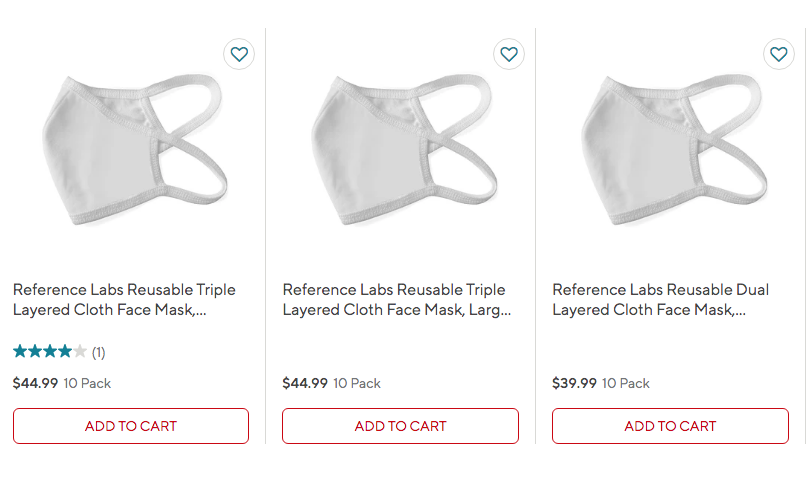Masks and face coverings seem poised to become a wardrobe essential in the COVID-19 new reality.

As Canadians all over the country begin to venture outside in greater numbers, the federal government is now recommending that everyone who can’t maintain a two-metre physical distance from others wear a non-medical mask.
While public health officials emphasize that wearing a mask is no substitute for social distancing and handwashing, they add that face coverings are an additional measure that may help limit the spread of the novel coronavirus.
A number of major retailers, from Starbucks to Whole Foods, are also “requesting” that in-store shoppers use face coverings.
You’ll also need a mask if you’re planning to board a plane anytime soon. Having a non-medical mask or face covering has been a requirement for air travellers in Canada since April 20.

Many Canadians have taken to sewing their own masks. Online tutorials on how to do so abound, including from official sources like the Centers for Disease Control and Prevention (CDC) in the United States.
But if you aren’t DYI-inclined, here’s what you should know about shopping online for a cloth mask.

Where to buy cloth masks
Many fashion retail chains are now selling or taking orders for their own lines of COVID-19 face masks.

Get weekly health news
Roots Canada, for example, says it has repurposed its Toronto-based Leather Factory to make non-medical face masks.
The face coverings, available in salt-and-pepper or solid colour patterns, sell for $22 apiece.
https://www.instagram.com/p/CAVSZi7h6dU/
Gap Canada is taking pre-orders on a new batch of adult-size reusable face masks with shipping expected for mid to late June depending on the model. A pack of three costs $20, according to the website.
Gap Kids is also taking orders for kid-size masks. (Note, however, that children under the age of two should not wear masks, according to Canadian and U.S. public health officials.)
Old Navy, which is part of The Gap, Inc., is also taking orders for colourful cloth masks, with a five-pack for adults selling for $15.
https://www.instagram.com/p/B_8FTaPjN2h/
Vancouver-based Kit and Ace is working on its own cloth mask. Customers can register now on the retailers’ website. Masks sell for $15 each.
https://www.instagram.com/p/B-9lDzyhJ1p/
Fashion brand Frank and Oak has put its Montreal-based staff at working sewing hand-made masks prices at $24 for a pair. Currently, however, the retailer has suspended its waitlist as catches up on orders.
If you’re looking for affordable, no-frills masks you can buy in bulk, Staples Canada is selling sets of 10 for between $39.99 and $44.99 in sizes small, medium and large, according to the retailer’s website.
If you’re eager to help out independent businesses or are looking for alternatives to large retailers who’ve temporarily run out of stock, you’ll find plenty of choice through online crafts marketplace Etsy.
You can also find plenty of brands and artisanal mask-makers advertising their own masks on Instagram and Facebook.

How many cloth masks are you likely to need?
You should wash your cloth masks and do so frequently, according to health experts.
Mask wearers should take their face coverings for a spin in the washing machine “routinely depending on frequency of use,” according to the CDC.
The Mayo Clinic recommends doing so “after every day of use.”
All this suggests you may need to have more than one mask at hand, although you could also wash your one mask, hang it up to dry overnight and have it ready to go the next morning, according to Suzanne Willard, associate dean of global health at Rutgers University’s School of Nursing.

What makes a good cloth mask?
Cloth masks for COVID-19 should be made of at least two layers of tightly-woven fabric such as cotton or linen, according to Canadian government guidelines.
Willard adds the material should be breathable, too.
“When you start getting into the nylons — the non-natural fabrics — then it increases the chances of you sweating,” she said.
That, in turn, causes your mask to get wet and lose its integrity, making it easier for viruses and bacteria to move back and forth, she added.
Canada’s official guidelines advise Canadians to change their masks as soon as possible if they become damp or dirty.
Cloth masks should also fit snugly on your face covering both mouth and nose, according to health experts. If you’re buying online, Willard suggests opting for models that are made of rectangular, folded cloth.
Those models are more likely to fit different face shapes and sizes than form-fitting masks, Willard says.
She also recommends opting for earloops rather than strings, especially if you’ll be wearing your mask for long periods of time. The problem with strings that tie around the head, she said, is that over time they can become looser and move around.
Some masks also include a pocket that allows for an additional, removable layer.
You can fill that with something like a coffee filter or the kind of filter you’d use for your heater, Willard said.
There’s no research on whether putting those filters between yourself and the outside world actually provides added protection, she noted. But if it makes you feel more comfortable, there’s no harm in it, she added.
That said, you should not use N95 filters in your cloth masks, Willard noted. Adding a medical-grade filter isn’t going to be as effective as wearing an N95 mask and takes away from the supply of personal protective equipment that should be going to front-line workers, she wrote via email.
When it comes to your cloth mask, she added, “the most important thing is to wear it and wear it correctly.”












Comments